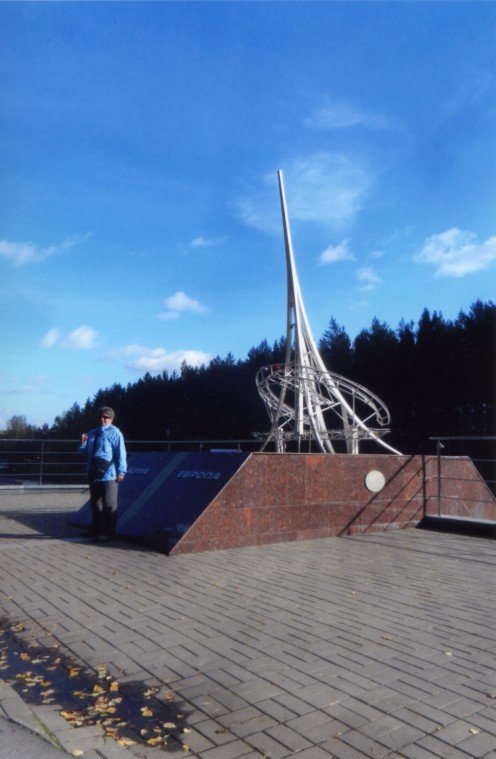“Traveling the Trans-Siberian Railway is on my bucket list as something to do before I kick the bucket!” Gilroy’s Pastor Paul Sweet laughed as he began his presentation at the United Methodist Church on Tuesday, Oct. 9, about his September trip on the Trans-Siberian Railway. A train buff, he had always had the dream of making this trip in his lifetime. But being a full-time pastor and a district superintendent in the United Methodist Church for many years made it a challenge.
Now finally retired, he is taking every opportunity to check off those bucket items, many of which include world travel.
As he began his presentation of slides showing the sights from the train all across Russian, Siberia, Mongolia, etc., the audience asked him, “Why the Trans-Siberian Railway?”
“The railway was built between 1896 and 1902 and is the longest in the world,” Sweet answered. “It’s 6,570 miles long. I passed through seven different time zones. I had to roll my watch back every night!”
“It was a unique opportunity to visit places like Mongolia and Siberia and get such a different perspective. Siberia is not like what we picture, just dark and frozen tundra where you go when you’ve done something really bad. It actually has beautiful countryside for many miles filled with Aspen and Pine trees whose leaves are turning fall colors!”
South of Siberia, the train stopped for a picnic with scenic views of the deepest lake in the world. It contains 20 percent of the world’s fresh water.
“Lake Baikal is 25 million years old but looks like new!” Sweet described. “The reason is that it formed as an ancient rift valley where the earth’s crust pulls apart; it is the deepest continental rift on earth at 5,387 feet deep, which is below sea level. It is still growing annually. If all the world’s freshwater disappeared tomorrow, this one lake could supply the entire world with water for forty years!”
The surface area is more than 12,000 square miles. It required the building of 200 bridges and 33 tunnels for the railway to make its way around the lake.
He went on the two-week journey alone, but while on the train he joined a group that included some Stanford alumni that he enjoyed getting to know. They enjoyed eating Russian Sasha (like cream of wheat but with different items added each day, such as nuts, bacon bits, or berries), sampling the local brew of fermented horse milk, and discussing what new revelations the day would bring.
The train stations were large, ornate edifices, harking back to the splendor of train travel in the past. It was surprising to Paul to see old American-made train engines on display in Russia, where they are greatly appreciated and preserved. The huge train yards are well kept; there is painting going on all the time; the railway ties are made of concrete. The well-designed train compartments look more like the 1960’s style, and they contain showers and beds that fold down. For many villages, trains are the only way to get in and out. The platforms are 100 yards long.
At the marker between Asia and Europe, Paul was able to stand with one foot in two continents simultaneously. In an Asian tradition, visitors tie yellow ribbons around the trees there for good luck. One thing Sweet noted is the way that Muslim mosques, Russian Orthodox churches, and Buddhist temples exist side by side and yet there has been little conflict. In Moscow, lots of building is under way to prepare for the World Soccer Cup being held there in 2014.
“Just outside town, the train stopped and switched engines, from electric to steam, so that we could roll into the City in dramatic traditional style!”
Another unusual site that was of particular interest to a pastor was the view along the path of the railway was the Church on Blood in Honour of All Saints Resplendent in the Russian Land is built on the site of the Ipatiev House in Yekaterinburg, where Nicholas II, the last Emperor of Russia and his family was shot by the Bolsheviks during the Russian Civil War. The family has been canonized, and the church was built to commemorate the Romanov sainthood. Giant photos of the family members are on display outside the church, where its gold domes contrast strikingly with the deep blue of the sky above.
It was perhaps a bittersweet journey in the sense that Sweet tragically lost his wife last December to cancer at only age 56; otherwise, he would have been making this journey with her. In spite of working hard as a very busy and always service-oriented couple. Vicki Sweet was a nurse practitioner who cared for children with developmental disabilities and chronic conditions, including genetic and metabolic disorders. Their love was irresistibly demonstrated with the occasional grand romantic gesture, such as the time Paul once flew his wife to Paris for a surprise dinner. She had no idea where they were going, but it was literally a “date night in Paris.”
As Sweet journeys on through the rest of his bucket list, we in Gilroy hope to hear more about his upcoming travels, which include extended stays in Scotland, Vietnam, and Cambodia, to visit Angkor Wat, the largest Hindu temple complex in the world.













